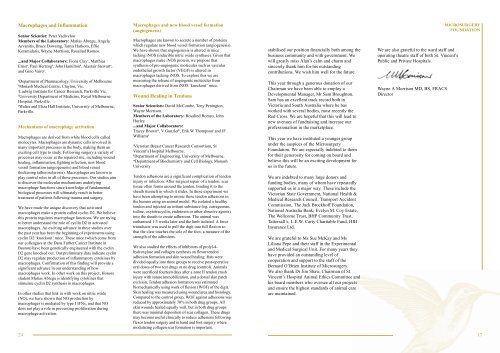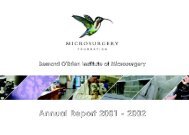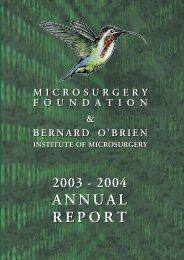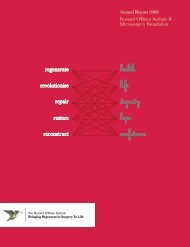annual report - O'Brien Institute
annual report - O'Brien Institute
annual report - O'Brien Institute
Create successful ePaper yourself
Turn your PDF publications into a flip-book with our unique Google optimized e-Paper software.
Macrophages and Inflammation<br />
Senior Scientist: Peter Vadiveloo<br />
Members of the Laboratory: Matias Abregu, Angela<br />
Arvanitis, Bruce Dowsing, Tanya Harkom, Effie<br />
Keramidaris, Wayne Morrison, Rosalind Romeo.<br />
...and Major Collaborators: Fiona Clay c , Matthias<br />
Ernst c , Paul Hertzog b , John Hamilton d , Alastair Stewart a ,<br />
and Gino Vairo e .<br />
aDepartment of Pharmacology, University of Melbourne<br />
bMonash Medical Centre, Clayton, Vic.<br />
cLudwig <strong>Institute</strong> for Cancer Research, Parkville Vic.<br />
dUniversity Department of Medicine, Royal Melbourne<br />
Hospital, Parkville.<br />
eWalter and Eliza Hall <strong>Institute</strong>, University of Melbourne,<br />
Parkville.<br />
Mechanisms of macrophage activation<br />
Macrophages are derived from white blood cells called<br />
monocytes. Macrophages are dynamic cells involved in<br />
many important processes in the body, making them an<br />
exciting cell type to study. Following surgery a variety of<br />
processes may occur at the repaired site, including wound<br />
healing, inflammation, fighting infection, new blood<br />
vessel formation (angiogenesis) and blood vessel<br />
thickening (atherosclerosis). Macrophages are known to<br />
play central roles in all of these processes. Our studies aim<br />
to discover the molecular mechanisms underlying<br />
macrophage functions since knowledge of fundamental<br />
biological processes will ultimately result in better<br />
treatment of patients following trauma and surgery.<br />
We have made the unique discovery that activated<br />
macrophages make a protein called cyclin D2. We believe<br />
this protein regulates macrophage functions. We are trying<br />
to better understand the role of cyclin D2 in activated<br />
macrophages. An exciting advance in these studies over<br />
the past year has been the beginning of experiments using<br />
cyclin D2 ‘knockout’ mice. These mice (which come from<br />
our colleagues at the Dana Farber Cancer <strong>Institute</strong> in<br />
Boston) have been genetically engineered with the cyclin<br />
D2 gene knocked out. Our preliminary data indicate cyclin<br />
D2 may regulate production of inflammatory cytokines by<br />
macrophages. Confirmation of this finding will provide a<br />
significant advance in our understanding of how<br />
macrophages work. In other work on this project, Honors<br />
student Matias Abregu is identifying cytokines that<br />
stimulate cyclin D2 synthesis in macrophages.<br />
In other studies that link in with work on nitric oxide<br />
(NO), we have shown that NO production by<br />
macrophages is mediated by type I IFNs, and that NO<br />
does not play a role in preventing proliferation during<br />
macrophage activation.<br />
Macrophages and new blood vessel formation<br />
(angiogenesis)<br />
Macrophages are known to secrete a number of proteins<br />
which regulate new blood vessel formation (angiogenesis).<br />
We have shown that angiogenesis is altered in mice<br />
lacking iNOS (inducible nitric oxide synthase). Given that<br />
macrophages make iNOS protein, we propose that<br />
synthesis of pro-angiogenic molecules such as vascular<br />
endothelial growth factor (VEGF) is altered in<br />
macrophages lacking iNOS. To explore this we are<br />
measuring the release of angiogenic molecules from<br />
macrophages derived from iNOS ‘knockout’ mice.<br />
Wound Healing in Tendons<br />
Senior Scientists: David McCombe, Tony Penington,<br />
Wayne Morrison.<br />
Members of the Laboratory: Rosalind Romeo, John<br />
Hurley.<br />
...and Major Collaborators:<br />
Tracey Brown m , V Gunzler k , Erik W Thompson j and JF<br />
Williams k<br />
jVictorian Breast Cancer Research Consortium, St<br />
Vincent’s Hospital Melbourne.<br />
kDepartment of Engineering, University of Melbourne.<br />
mDepartment of Biochemistry and Cell Biology, Monash<br />
University<br />
Tendon adhesions are a significant complication of tendon<br />
injury or infection. After surgical repair of a tendon, scar<br />
tissue often forms around the tendon, binding it to the<br />
sheath (tunnel) in which it slides. In these experiment we<br />
have been attempting to mimic these tendon adhesions in<br />
the human using an animal model. We isolated a healthy<br />
tendon and injected an irritant substance (eg. carrageenan,<br />
iodine, oxytetracyclin, endotoxin or other abrasive agents)<br />
into the sheath to create adhesions. The animal was<br />
euthanised 1-3 weeks later and the limb isolated. A force<br />
transducer was used to pull the digit into full flexion so<br />
that the claw touches the sole of the foot, a measure of the<br />
strength of the adhesions.<br />
We also studied the effects of inhibitors of prolyl-4hydroxylase<br />
and collagen synthesis on flexor tendon<br />
adhesion formation and skin wound healing. Rats were<br />
divided equally into three groups to receive post-operative<br />
oral doses of two test drugs or no drug (control). Animals<br />
were sacrificed fourteen days after a zone II tendon crush<br />
injury with suture immobilization, and a dorsal skin patch<br />
excision. Tendon adhesion formation was estimated<br />
biomechanically using work of flexion (WOF) of the digit.<br />
Skin healing was measured using wound area and histology.<br />
Compared to the control group, WOF against adhesions was<br />
reduced by approximately 70% in both drug groups. All<br />
skin wounds healed equally well, but in both drug groups<br />
there was minimal deposition of scar collagen. These drugs<br />
may become useful clinically to reduce adhesions following<br />
flexor tendon surgery and in hand and foot surgery where<br />
modulating collagen scar formation is important.<br />
stabilised our position financially both among the<br />
business community and with government. We<br />
will greatly miss Alan’s calm and charm and<br />
sincerely thank him for his outstanding<br />
contributions. We wish him well for the future.<br />
This year through a generous donation of our<br />
Chairman we have been able to employ a<br />
Developmental Manager, Mr Sam Broughton.<br />
Sam has an excellent track record both in<br />
Victoria and South Australia where he has<br />
worked with several bodies, most recently the<br />
Red Cross. We are hopeful that this will lead to<br />
new avenues of fundraising and increase our<br />
professionalism in the marketplace.<br />
This year we have instituted a younger group<br />
under the auspices of the Microsurgery<br />
Foundation. We are especially indebted to them<br />
for their generosity for coming on board and<br />
believe this will be an exciting development for<br />
us in the future.<br />
We are indebted to many large donors and<br />
funding bodies, many of whom have repeatedly<br />
supported us in a major way. These include the<br />
Victorian State Government, National Health &<br />
Medical Research Council, Transport Accident<br />
Commission, The Jack Brockhoff Foundation,<br />
National Australia Bank, Evelyn M. Coy Estate,<br />
The Wellcome Trust, BHP Community Trust,<br />
Tattersall’s, L.E.W. Carty Charitable Fund, HIH<br />
Insurance Ltd.<br />
We are grateful to Ms Sue McKay and Ms<br />
Liliana Pepe and their staff in the Experimental<br />
and Medical Surgical Unit. For many years they<br />
have provided an outstanding level of<br />
cooperation and support to the staff of the<br />
Bernard O’Brien <strong>Institute</strong> of Microsurgery.<br />
We also thank Dr Jim Shaw, Chairman of St.<br />
Vincent’s Hospital Animal Ethics Committee and<br />
his board members who oversee all our projects<br />
and ensure the highest standards of animal care<br />
are maintained.<br />
We are also grateful to the ward staff and<br />
operating theatre staff of both St. Vincent’s<br />
Public and Private Hospitals.<br />
Wayne A Morrison MD, BS, FRACS<br />
Director<br />
MICROSURGERY<br />
FOUNDATION<br />
24 17






